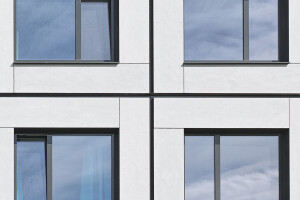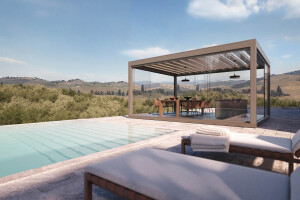The basic strategy in the design of the building led to the minimisation of the volume and lightening of the object. The building mass was divided into a pair of towers. Both towers are connected by a neck at two-thirds height. From this height level, the towers continue separately whereby\ each of them has a separate vertical axis, composition and identity. The towers mutually draw apart and attract each other. The male and female principle. Tension is generated between the towers - dialogue. The mass expanding upwards is usually the most lucrative space and the narrowing downwards minimises the ground appropriation and releases space for trees and the pedestrian partere, which freely runs under the building. This recessing moreover created continuous loggia - terraces around the perimeter of the building, which clearly indicate residential function. The arrangement of the ceiling tiles vertically in combination with the various slanting and receding masses of the towers shall simply change optically in relation to the distance of the observer and will always create interesting building graphics. All the 120 flats from small studios to large apartments and four storey penthouses with own gardens and swimming pools on the roof are designed in a freely merging space. Above the ground floor, below the 3rd floor is a block with gym and swimming pool for the residents. The ground floor is taken up by only vertical cores and the reception desk, the rest of the area consists of park greenery. As the first residential project in europe, v tower, prague aspires to win leed platinum certification, which is the most stringent set of requirements for human comfort, sustainability and efficiency.





















































